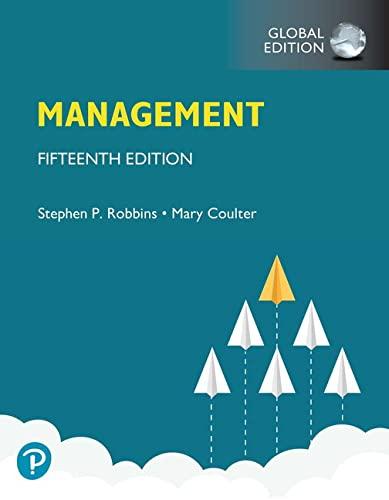In India, only about 20 cities out of 87 have organized transport and fewer can lay claim
Question:
In India, only about 20 cities out of 87 have organized transport and fewer can lay claim to a mass rapid transit system. A collaboration between India’s Tata Motors and Brazil’s Marcopolo, it specializes in coach and bus manufacturing, combining Marcopolo’s expertise and knowledge of engineering buses with Tata’s manufacturing global success to meet India’s growing demand for public transportation. In 2008, the joint venture Tata Marcopolo Motors Ltd (TTM) was created, employing over 2,500 people in Dharwad, India. To manage a venture like this in a changing business environment, a flexible and adaptable structure is necessary. Thus, when TTM implemented self-managed teams at its Dharwad plant in 2011, as a part of its employee engagement program, it seemed to be the best solution. Without formal management, responsibilities are decentralized and employees are encouraged to adopt coaching roles rather than dictating granular tasks. It created a team that had augmented authority and ownership over tasks. The collaborative process increased their motivation and productivity. It also improves communications, which may be effective at higher levels, but often fail at local levels.
The interpersonal skills of coaches, team leaders, and local managers are critical as they form close working relationships with frontline workers develop. TTM achieves this by having regular open house sessions, face-to-face meetings, and team meetings.
Remember this team is responsible for manufacturing buses to meet the constant demand of a population of over a billion. To ensure the work processes are near seamless, the HR at TTM collects feedback from all employees to map and reward skills and innovative work processes. The HR works with the team to establish the desired technician criteria, developing a manufacturing flow to ensure better understanding, which includes services, utilities, and lab. It also means TTM will need to map its technology and processes—
technology involved, tasks to be performed, skills required, and standards of performance for optimal efficiency and productivity. This enables teams to make decisions regarding planning, delivering, and monitoring workloads. Some employees at TTM stated that the advantages of such team types included high level of intrinsic motivation, increased problem solving and conflict management, and more ownership and accountability.
However, despite the benefits it turns out this was no easy task. The bumps on the road included insufficient planning time due to unrealistic expectations, which often result in failures. Empowering employees who lack decision-making skills lead to wrong decisions and wastage of time. In addition, not all employees may be good team players. A misfit will disturb the team’s equilibrium.
Are self-managed teams really the light at the end of the tunnel? Important factors to consider when selecting this team type are employee experience and skill level, and cultural preference. In relation to Hofstede’s cultural dimensions, India scores high on power distance dimension, indicating that employees are more suited to a work environment where there is a string hierarchy and clear direction given. Organizations will need management to commit to monitor and make the approach work. As selfmanaged teams can be both enabling and coercive, the role of the coach is important as a facilitator of team discussions and problem solving.
While TTM continues to believe that self-managed teams are the way forward, it has since adapted its approaches to create an effective work environment. By surveying employees before and after the implementation, the approach has been modified to create a culture that promotes productive teamwork.48
DISCUSSION QUESTIONS:
13-11. What are some of the challenges of self-managed teams at TTM? How should it deal with them?
13-12. What factors should be considered when implementing self-managed teams?
13-13. Would the different group development stages apply to this team? How?
13-14. Do you think TTM did a good job of implementing self-managed teams? Why?
Step by Step Answer:






